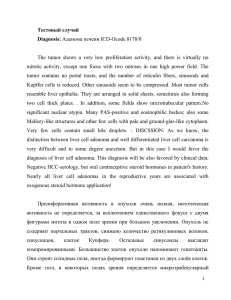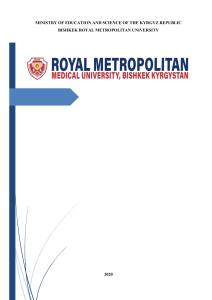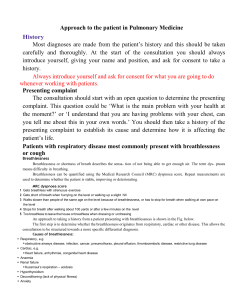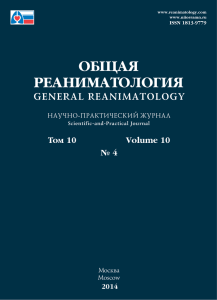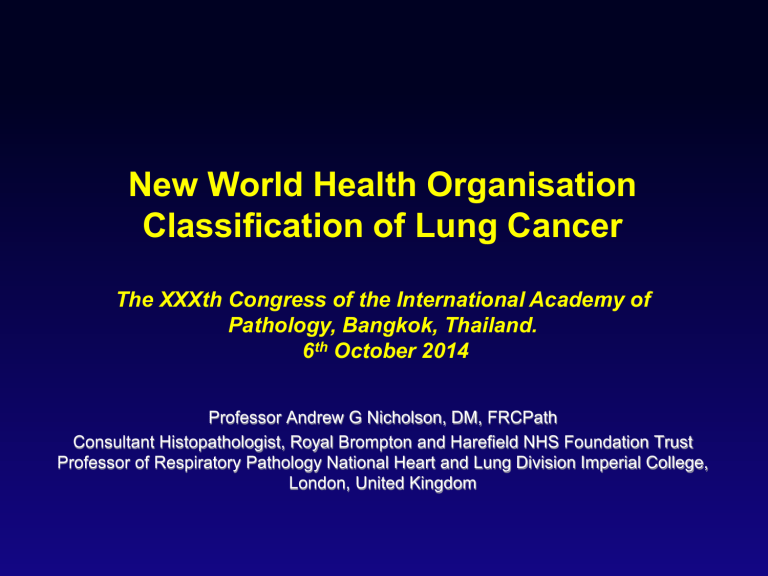
New World Health Organisation
Classification of Lung Cancer
The XXXth Congress of the International Academy of
Pathology, Bangkok, Thailand.
6th October 2014
Professor Andrew G Nicholson, DM, FRCPath
Consultant Histopathologist, Royal Brompton and Harefield NHS Foundation Trust
Professor of Respiratory Pathology National Heart and Lung Division Imperial College,
London, United Kingdom
WHO classification
1981-1999-2004-2015
•
THE REQUIREMENTS OF A CLASSIFICATION SYSTEM...
•
REPRODUCIBLE (strict and recognisable set of criteria…)
•
GLOBALLY APPLICABLE (…that everyone can apply…)
•
THOROUGH (…which can deal with atypical variants…)
•
DYNAMIC
(…adapts to recent advances.)
WHO classification
1981-1999-2004-2015
•
THE REQUIREMENTS OF A CLASSIFICATION SYSTEM...
•
REPRODUCIBLE (strict and recognisable set of criteria…)
•
GLOBALLY APPLICABLE (…that everyone can apply…)
•
THOROUGH (…which can deal with atypical variants…)
•
DYNAMIC
(…adapts to recent advances.)
WHO CLASSIFICATIONS
•
•
•
•
•
1967 – Histologic Typing of Lung Tumours
1981 – Histologic Typing of Lung Tumours
1999 – Histologic Typing of Tumours of the
Lung and Pleura
2004 – Pathology and Genetics: Tumours of
the Lung, Pleura, Thymus and Heart
2015 - Pathology and Genetics: Tumours of
the Lung, Pleura, Thymus and Heart
INCREASING COMPLEXITY
•
•
•
•
1967 WHO
1981 WHO
1999 WHO
2004 WHO
•
•
•
•
•
2015 WHO
•
H&E
H&E & Mucin
H&E, EM & IHC
H&E, EM, IHC &
Genetics
H&E, Cytology, IHC,
Genetics, Mucin,
Radiology
PERSONALISED MEDICINE:
INCREASING RELEVANCE
2015 WHO CLASSIFICATION
•
1-1: Introduction
1-1A Lung cancer staging and
grading
1-1B Rationale for classification
in small biopsies and cytology
1-1C Terminology and criteria in
non-resection specimens
1-1D Molecular testing for
treatment selection in lung
cancer
•
1-2: Adenocarcinoma
1-2A Invasive adenocarcinoma
1-2B Variants of invasive
adenocarcinoma
1-2C Minimally invasive
adenocarcinoma
•
1-2: Adenocarcinoma (continued)
1-2D Preinvasive lesions
1-2D-i: Atypical adenomatous
hyperplasia
1-2D-ii: Adenocarcinoma in
situ
•
1-3: Squamous cell carcinoma
1-3A: Keratinizing and
nonkeratinizing squamous cell
carcinoma
1-3B: Basaloid carcinoma
1-3C: Preinvasive lesion:
Squamous carcinoma in situ
2015 WHO CLASSIFICATION
•
1-4: Neuroendocrine Tumours
•
1-6: Adenosquamous
carcinoma
•
1-7: Sarcomatoid carcinoma
1-4A: Small cell carcinoma
1-4B: Large cell
neuroendocrine
carcinoma
•
1-7A: Pleomorphic, spindle
cell and giant cell carcinoma
1-4C: Carcinoid tumors
1-7B: Carcinosarcoma
1-4D: Preinvasive lesion:
Diffuse idiopathic pulmonary
neuroendocrine cell
hyperplasia
1-7C: Pulmonary blastoma
1-5: Large cell carcinoma
•
1-8: Other carcinomas
1-8A: Lymphoepithelioma-like
carcinoma
1-8B: NUT-carcinoma
2015 WHO CLASSIFICATION
1-9: Salivary gland-type tumours
1-9A Mucoepidermoid carcinoma
1-9B Adenoid cystic carcinoma
1-9C Epithelial-myoepithelial carcinoma
1-2D Pleomorphic adenoma
1-10: Papillomas
1-10A: Squamous papilloma
1-10B: Glandular papilloma
1-10C: Mixed squamous and glandular papilloma
1-11: Adenomas
1-11A:
1-11B:
1-11C:
1-11D:
Sclerosing pneumocytoma
Alveolar adenoma
Papillary adenoma
Mucinous cystadenoma
1-12: Mesenchymal tumours, cont’d
1-12H: Pleuropulmonary blastoma
1-12I: Synovial sarcoma
1-12J: Pulmonary artery intimal saraoma
1-12K: Pulmonary myxoid sarcoma with EWSR1CREB1 translocation
1-12L: Myoepithelial tumours
1-12M: Others
1-13: Lymphoproliferative disorders
1-13A: Marginal zone B-cell lymphoma of MALT origin
1-13B: Diffuse large B-cell lymphoma
1-13C: Lymphomatoid granulomatosis
1-13D: Intravascular lymphoma
1-13E: Langerhans cell histiocytosis
1-13F: Erdheim Chester disease
1-11E: Mucus gland adenoma
1-12: Mesenchymal tumours
1-12A: Hamartoma
1-12B: Chondroma
1-12C: PEComatous tumours (LAM, PEComa)
1-12D: Congenital peribronchial myofibroblastic
tumour
1-12E: Diffuse lymphangiomatosis
1-12F: IMT
1-12G: Epithelioid haemangioedothelioma
1-14: Tumours of ectopic origin
1-14A: Germ cell tumours
1-14B: Intrapulmonary thymoma
1-14C: Melanoma
1-14D: Meningioma
1-15: Metastases to the lung
Outline…
•
THE REQUIREMENTS OF A CLASSIFICATION SYSTEM...
•
•
•
•
•
•
•
•
•
•
•
WHO classification
1981-1999-2004-2015
REPRODUCIBLE (strict and recognisable set of criteria…)
GLOBALLY APPLICABLE (…that everyone can apply…)
THOROUGH (…which can deal with atypical variants…)
DYNAMIC (…adapts to recent advances.)
Large cell carcinoma
Adenocarcinomas
Squamous cell carcinoma
Neuroendocrine tumours
Sarcomatoid carcinomas
Other carcinomas
Classification of biopsies in lung cancer
LARGE CELL CARCINOMA
2004
2015….
•
Large cell carcinoma
•
• Large cell neuroendocrine
•
•
•
• Null phenotype on IHC
• Unclear phenotype on IHC
• No IHC available
carcinoma 8013/3
Combined large cell
neuroendocrine carcinoma 8013/3
Basaloid carcinoma 8123/3
Lymphoepithelioma-like carcinoma
8082/3
• ADC on IHC (NOW UNDER ADC,
•
•
• Clear cell carcinoma 8310/3
• Large cell carcinoma with rhabdoid
phenotype 8014/3
Large cell carcinoma
solid subtype)
SQCC on IHC (NOW UNDER
NON-KERAT SQCC)
** Clear cell and rhabdoid (more
aggressive) are cytologic features with no
current prognostic/predictive significance,
but may be relevant to differential diagnosis
– comment as a percentage of tumour
Recent studies on correspondence of IHC profiles and mutations in LCC
Mod Pathol Epub Oct 2012
Arch of Pathol Epub June 2013
Virchows Arch Epub Nov 2013
Sci Transl Med Epub Oct 2013
Large cell carcinoma. Large tumour cells have abundant cytoplasm with large
nuclei, vesicular nuclear chromatin and prominent nucleoli. There is no
glandular or squamous differentiation, and no mucin vacuoles are present.
Courtesy of Dr L Carvalho.
A
D
G
P40
C
TTF-1
P40
E
F
TTF-1
H
P40
ITTF-1
Figure 1-05 4 Large cell carcinoma. (A-C) A resected morphologically undifferentiated non-small cell carcinoma, that would hitherto have been
classified as large cell carcinoma, stains for TTF-1 but not for p40, with subsequent classification as an adenocarcinoma, solid subtype (B – p40; C –
TTF-1). (B-F) A resected morphologically undifferentiated non-small cell carcinoma, that would hitherto have been classified as large cell carcinoma,
stains for p40 but not for TTF-1, with subsequent classification as a non-keratinising squamous cell carcinoma (E – p40; F –TTF-1). (G-I) A resected
morphologically undifferentiated non-small cell carcinoma does not stain for P40 or TTF-1. The tumour cells also did not contain mucin, with
subsequent classification as a large cell carcinoma, null phenotype (H – p40; I –TTF-1). Courtesy of Dr L Sholl
Subtyping of resected morphologically undifferentiated nonsmall cell carcinomas (formerly large cell carcinoma)
*p63 (4A4) can rarely be more diffusely positive in some TTF-1 positive tumours. These should
be classified as adenocarcinomas.
1In
cases where there is morphological evidence of either squamous cell carcinoma or
adenocarcinoma, then immunohistochemistry is not required to assess undifferentiated areas.
IHC typing of CK + morphologically undifferentiated NSCLC
(mucin stains already undertaken to exclude solid pattern ADC**).
Focal = 0-10% of cells positive, Diffuse = >10% of cells positive
TTF-1
P63
P40
CK5/6
DIAGNOSIS
DIAGNOSIS
(RESECTION)
(BIOPSY/CYTO)
Positive focal or diffuse
Negative
Negative
Negative
ADC
NSCLC, favour ADC
Positive focal or diffuse
Positive, focal or
diffuse
Negative
Negative
ADC
NSCLC, favour ADC
Positive focal or diffuse
Positive, focal or
diffuse
Positive, focal
Negative
ADC
NSCLC, favour ADC
Positive focal or diffuse
Negative
Negative
Positive, focal
ADC
NSCLC, favour ADC
Negative
Any one of above diffusely positive
SQCC
NSCLC, favour SQCC
Negative
Any one of above focally positive
LCC-unclear#
NSCLC-NOS
Negative
Negative
Negative
Negative
LCC-null***
NSCLC-NOS
No stains available
No stains
available
No stains available
No stains
available
LCC with no
additional
stains
NSCLC-NOS (no stains
available)
*Napsin may be used as an alternative to TTF-1. Although a sensitive marker, CK7 is not recommended as a marker of
adenocarcinomatous differentiation due to a lack of specificity.
** Positive for mucin is defined as (5 or more droplets in 2 consecutive high power fields in resections {2004 WHO book} and mucin
droplets in two or more cells within a biopsy). Fewer positive cells are regarded as negative.
*** Sarcomatoid carcinoma and neuroendocrine tumours should be excluded (i.e. undifferentiated morphology with no spindle/giant
cells).
# Negativity for TTF1 and focal positivity for p63/p40/CK5-6 point to adenocarcinoma cell lineage once neuroendocrine tumours are
excluded
Outline…
•
THE REQUIREMENTS OF A CLASSIFICATION SYSTEM...
•
•
•
•
•
•
•
•
•
•
•
WHO classification
1981-1999-2004-2015
REPRODUCIBLE (strict and recognisable set of criteria…)
GLOBALLY APPLICABLE (…that everyone can apply…)
THOROUGH (…which can deal with atypical variants…)
DYNAMIC (…adapts to recent advances.)
Large cell carcinoma
Adenocarcinomas
Squamous cell carcinoma
Neuroendocrine tumours
Sarcomatoid carcinomas
Other carcinomas
Classification of biopsies in lung cancer
WHO Classification Of Adenocarcinoma 2004
Adenocarcinoma
Mixed subtype
Acinar
Papillary
Bronchioloalveolar carcinoma
Nonmucinous
Mucinous
Mixed mucinous and non-mucinous
Solid adenocarcinoma with mucin
formation
Variants
Rationale For New ADC Classification
IASLC/ATS/ERS sponsored meeting(s)
Multidisciplinary criticisms in relation to 2004 classification…
•
Bronchioloalveolar carcinoma (BAC) – confusing used
many different ways despite 99/04 WHO; mucinous
and non-mucinous
•
No classification for biopsies
•
Greater clinical relevance (too “for pathologists by
pathologists”…)
•
Take into account rapid evolving molecular advances
(EGFR)
BAC
RIP
March 31,
2008
BAC –
BRONCHIOLOALVEOLAR
CARCINOMA
RIP – REST IN PEACE
ADENOCARCINOMA CLASSIFICATION
Travis WD et al. JTO Feb 2011;6:244-286
•
PREINVASIVE LESIONS
• AAH
• ADC-in-situ (formerly pure BAC) *most non-mucinous (NM) (30mm or
less)
•
INVASIVE
l invasive (< 5mm invasion) (30mm or less)
• Minimally
•
•
•
•
•
Lepidic pattern predominant
Acinar pattern predominant/pure
Papillary pattern predominant/pure
Micropapillary pattern predominant/pure
Solid pattern predominant/pure
• Invasive mucinous carcinomas
• Colloid
• Fetal (low and high grade)
• Enteric
… A multidisciplinary approach
Respiratory Physician
Imaging
Surgery
Oncology
Pathology
Molecular Biology
Adenocarcinoma in situ (AIS)
ADENOCARCINOMA-IN-SITU
Minimally Invasive Adenocarcinoma (MIA)
Minimally invasive adenocarcinoma
? 5mm or less = “microinvasion”
No necrosis
No lymphatic or pleural invasion
No spread through alveolar spaces (STAS)
2a
2b
2c
2d
??? New pattern…
The cribriform pattern identifies a subset of acinar predominant tumors with
poor prognosis in patients with stage I lung adenocarcinoma: a conceptual proposal to classify
cribriform predominant tumors as a distinct histologic subtype.
Kadota K et al. Mod Pathol Mod Pathol 2014; 27: 690-700
The many faces of BAC…
•
PREINVASIVE LESIONS
• AAH
• ADC-in-situ (formerly pure BAC) *most non-mucinous (NM) (30mm or less)
•
INVASIVE ADC
•
•
•
•
•
•
Minimally invasive (< 5mm invasion, <5mm scar (30mm or less)
Lepidic pattern predominant
Acinar pattern predominant/pure
Papillary pattern predominant/pure
Micropapillary pattern predominant/pure
Solid pattern predominant/pure
• Mucinous carcinomas
• Fetal (low and high grade)
• Enteric
Updated ADC Classification ...is it working?
• IO variation
• Kappas range from moderate to good for
classic cases (problem with definition of
invasion)
• PREDOMINANT PATTERN
• Several papers, higher stages different
countries
• CORRELATION WITH MOLECULAR
SUBTYPES
• Predominant pattern, Signet ring, TTF-1 +ve
REPRODUCIBILITY
–Mod Path 25:1574,
2012
Selected images: kappa
Typical patterns: 0.77
Difficult cases: 0.38
Invasion vs noninvasion
Typical: 0.55
Difficult: 0.08
–ERJ 40:1221-27, 2012
Predominant pattern : Kappa
Lung Pathologists:
substantial (0.44-.72)
Residents: fair (0.38-0.47)
–Virch Arch 461:185-93, 2012
Digital images:
Consensual votes: 59.6-75%
Disagreement decreased
significantly after educational
sessions (p<0.001)
Predominant pattern - Validation...
“A grading system of lung ADC
based on histologic pattern
is predictive….in stage I
tumors. Sica G AJSP
2010;34:1155
USA
“Does lung adenocarcinoma
subtype predict patient
survival?;….” Russell PA
et al. JTO 2011;6:1496
“Prognostic significance of
ADC patterns... Von der
Thusen JTO 2013;8:3744
Australia
Warth A, J Clin Oncol
2013; 30: 1438-46
Xu L et al: AJSP
2012;36:273-282
Yoshizawa A, et al: J Thor Oncol
2013;8: 52-61
UK
Adenocarcinoma
Cell morphology variants
(note, if present, in 5% increments)
•
No prognostic
significance
No molecular correlation
•
No molecular
correlation
Ensure not sarcoma
metastasis
•
Ensure not metastasis
•
Poorer prognosis
• >50% tumour signet ring
•
Poorer prognosis
• >10% tumour
•
Correlation with EML4-ALK
translocation…
- Moderate positive predictor
- Poor negative predictor
•
•
Ensure not metastasis (GI)
•
ADENOCARCINOMA CLASSIFICATION
•
PREINVASIVE LESIONS
• AAH
• ADC-in-situ (formerly pure BAC) *most non-mucinous (NM)
•
INVASIVE ADC
• Minimally invasive (to be defined: < 5mm invasion, <10% invasion,
•
•
•
•
•
<5mm scar)
Lepidic pattern predominant
Acinar pattern predominant/pure
Papillary pattern predominant/pure
Micropapillary pattern
Solid pattern predominant/pure
• Invasive mucinous carcinomas
• Fetal (low and high grade)
• Colloid
• Enteric
INVASIVE MUCINOUS ADENOCARCINOMA
MUCINOUS AIS and MIA ARE
VERY RARE BUT CAN OCCUR
Prognostic Significance of Adenocarcinoma In Situ,
Minimally Invasive Adenocarcinoma, and Nonmucinous
Lepidic Predominant Invasive Adenocarcinoma of the
Lung in Patients With Stage I Disease.
Kadota, K et al. American Journal of Surgical Pathology.
38(4):448-460, April 2014.
Variants…
Enteric Adenocarcinoma
Well-differentiated fetal
adenocarcinoma
Low and high Grade
variants of WDFA....
Colloid
carcinoma
Outline…
•
THE REQUIREMENTS OF A CLASSIFICATION SYSTEM...
•
•
•
•
•
•
•
•
•
•
•
WHO classification
1981-1999-2004-2015
REPRODUCIBLE (strict and recognisable set of criteria…)
GLOBALLY APPLICABLE (…that everyone can apply…)
THOROUGH (…which can deal with atypical variants…)
DYNAMIC (…adapts to recent advances.)
Large cell carcinoma
Adenocarcinomas and new subtypes
Squamous cell carcinoma
Neuroendocrine tumours
Sarcomatoid carcinomas
Other carcinomas
Classification of biopsies in lung cancer
SQUAMOUS CELL CARCINOMA (SQCC)
“A malignant epithelial tumour showing keratinization and/or
intercellular bridges that arises from bronchial epithelium”
ADC now more common but SQCC still comprises 20-30% of lung
cancers.
Images from WHO 2004
Squamous cell carcinoma (WHO 2004)
• Squamous cell carcinoma;
variants:
– Papillary
– Clear cell
– Small cell
– Basaloid
• Adenosquamous carcinoma
• Large cell carcinoma:
– Basaloid carcinoma subtype
• Pre-invasive lesions:
– Squamous cell carcinoma in
Images from WHO 2004 and Pathology of the Lung. Ed. Corrin and Nicholson)
situ
Moro-Sibilot et al. ERJ 2008;31:854-59
Lung carcinomas with a baslaoid pattern
•
1979-2003: 90 of 1418 NSCLCs were classified as:
– Basaloid variant of large cell carcinoma
(n=46)
– Basaloid variant of squamous cell carcinoma
(n=44)
•
Diagnostic criteria:
–
Relatively small cells with high mitotic rate
–
Forming lobular pattern with peripheral palisading and comedo-type
necrosis
–
Negative NE IHC markers (or <10% tumor cells) to exclude NE carcinoma
–
LCC variant: No intercellular bridges or individual cell keratinization, foci
of abrupt pearl formation without progressive squamous maturation
–
SCC variant: Presence of squamous differentiation in <50%
–
The survival of basaloid variants of LCC and SCC was
comparable.
–
Median and overall survival were significantly lower
for BC than for NSCLC in stage I-II patients, with a
median survival of 29 and 49 months, respectively,
and 5-yr survival rates of 27 and 44% for BC and
NSCLC.
When disease-specific survival was considered, BC
had a shorter survival than both NSCLC and SCC
–
Kim DJ, Kim KD, Shin DH, Ro JY, Chung KY. Basaloid
carcinoma of the lung: a really dismal histologic variant?
Ann Thorac Surg 2003 December;76(6):1833-7.
(N=35)
“Basaloid carcinoma of the lung does not have a worse
prognosis than the other nonsmall cell lung cancers.”
Basaloid pattern confers a poor prognosis in nonsmall cell lung carcinoma,
especially in stage I-II patients.
Squamous carcinoma sequence
Normal
Basal
Cell
hyperplasia
•
WHO/IASLC grading system
(mild moderate and severe dysplasia,
ca-in-situ).
•
Reproducible (Nicholson AG et al.
Histopathology 2001: 38; 202-208.)
Squamous
Metaplasia/
Mild
Dysplasia
Carcinoma in situ
Outline…
•
THE REQUIREMENTS OF A CLASSIFICATION SYSTEM...
•
•
•
•
•
•
•
•
•
•
WHO classification
1981-1999-2004-2015
REPRODUCIBLE (strict and recognisable set of criteria…)
GLOBALLY APPLICABLE (…that everyone can apply…)
THOROUGH (…which can deal with atypical variants…)
DYNAMIC (…adapts to recent advances.)
Large cell carcinoma
Adenocarcinomas and new subtypes
Squamous cell carcinoma
Neuroendocrine tumours
Sarcomatoid carcinomas
Classification of biopsies in lung cancer
2015 WHO CLASSIFICATION
NEUROENDOCRINE TUMORS
• Small cell carcinoma
•
•
•
• Combined SCLC
Large cell neuroendocrine carcinoma
• Combined LCNEC
Carcinoid tumor
• Typical carcinoid
• Atypical carcinoid
Pre-invasive lesion: Diffuse idiopathic
neuroendocrine cell hyperplasia (DIPNECH)
Typical carcinoid
Gross pathology….
Typical carcinoid
Gross pathology….
Typical carcinoid
Microscopic patterns….
Typical carcinoid
Microscopic patterns….
Typical carcinoid
Tricks that it may play….
Spindle
Rhabdoid
Atypical carcinoid
Number crunching….
•
•
•
•
•
•
•
Make up 11-24% of bronchopulmonary
carcinoid tumours
Greater percentage are peripheral
Patients slightly older than for TC
More often seen in smokers
Commoner to have ectopic endocrine activity
5yr survival - 60-70% (versus 90-98% for TC)
10yr survival -35-59% (versus 82-95% for
TC)
Atypical carcinoid
Diagnostic features….
•
Foci of necrosis
(generally small)
•
and/or
•
2-10 mitoses/2mm
•
Greater architectural
disorganisation
Increased pleomorphism
Increased incidence of regional
metastases
•
•
2
**
** ?further subdivision into 2-5 and 6-10 per 2mm2
Pre-neoplastic disease – NEH vs DIPNECH
NEH
TUMOURLET
A
C
B
CD56
DIPNECH + OB
A
B
C
DIPNECH – Review of 19 cases
•
•
•
•
9 symptomatic cases (Group 1)
10 cases as an incidental finding during
investigation for another disorder, most
frequently malignant disease (Group 2) – 7 of
these presenting since 2004
Most patients were female (n=15) and neversmokers (n=12/17), aged 31-67.
** Only two series in the literature over 14
years (of 6 and 5 cases respectively)
DIPNECH
+
Obliterative Bronchiolitis
Large cell neuroendocrine carcinoma
•
NE morphology AND NE
differentiation on IHC
•
•
necrosis more than punctate
mitoses >10/10hpf (usually
much higher)
•
large cell size >3 resting
lymphocytes
Low N:C ratio
Vesicular nuclei, nucleoli
frequent
•
•
•
Poorly responsive to
chemotherapy
Small cell carcinoma
•
Cytological criteria
• Size < 3 resting lymphocytes
• occasional large pleomorphic
nuclei accepted
• cell borders not seen
• high N:C ratio
• finely granular chromatin
• absent/inconspic nucleoli
•
Architectural features
• solid
• nested
• trabecular
• rosettes
• palisading
• Nuclear moulding
• encrustation nuclear material
vessel walls
Mitoses + Apoptosis
Ki 67 = >95%
Dot-like +ve MNF116
CD56
Outline…
•
THE REQUIREMENTS OF A CLASSIFICATION SYSTEM...
•
•
•
•
•
•
•
•
•
•
•
WHO classification
1981-1999-2004-2015
REPRODUCIBLE (strict and recognisable set of criteria…)
GLOBALLY APPLICABLE (…that everyone can apply…)
THOROUGH (…which can deal with atypical variants…)
DYNAMIC (…adapts to recent advances.)
Large cell carcinoma
Adenocarcinomas and new subtypes
Squamous cell carcinoma
Neuroendocrine tumours
Sarcomatoid carcinomas
Other carcinomas
Classification of biopsies in lung cancer
1.7 Sarcomatoid carcinoma
• Pleomorphic carcinoma
• Spindle cell carcinoma
• Giant cell carcinoma
• Carcinosarcoma
• Pulmonary blastoma
Pleomorphic carcinoma
•
Pleomorphic carcinoma
• Malignant giant/spindle cell
•
component (>10%) and NSCLC
component
Spindle cell carcinoma
• NSCLC composed solely of
•
spindle cells
Giant cell carcinoma
• NSCLC highly pleomorphic giant
•
cells
Rich inflammatory cell infiltrate
•
Poorer prognosis than other
NSCLC
•
Should we be using TTF-1, CK5/6,
P63, etc to refine LCUC to ADC
and SQCC if adjuvant therapy is
going to be related to, for example
“non-squamous histology”?
Carcinosarcoma
•
“A mixture of
carcinoma and
sarcoma containing
heterologous
elements”
Pulmonary blastoma
Biphasic tumour with WDFA
type epithelial component but
primitive mesenchymal stroma
which may contain
sarcomatous elements
1-8: Other carcinomas
MNF116
Lymphoepithelioma-like carcinoma
CD3 +ve, CD1a -ve
EBV
1-8: Other carcinomas
NUT-carcinoma
Young adults and children
P63 and CK positive
NUT-IHC and NUT-FISH to confirm diagnosis
Outline…
•
THE REQUIREMENTS OF A CLASSIFICATION SYSTEM...
•
•
•
•
•
•
•
•
•
•
•
WHO classification
1981-1999-2004-2015
REPRODUCIBLE (strict and recognisable set of criteria…)
GLOBALLY APPLICABLE (…that everyone can apply…)
THOROUGH (…which can deal with atypical variants…)
DYNAMIC (…adapts to recent advances.)
Large cell carcinoma
Adenocarcinomas and new subtypes
Squamous cell carcinoma
Neuroendocrine tumours
Pleomorphic carcinomas
Other carcinomas
Classification of biopsies in lung cancer
1-1B Rationale for classification in
small biopsies and cytology and 1-1C Terminology and
criteria in non-resection specimens:
(1999/2004) Malignant
• (2008-9)
Ca
NSCLC
SQCa
• Poorly diff NSCLC
If clinically relevant
- IHC (CK5/6,34BE12,p63,TTF-1)
- Mucin stain
- Expert referral
- Another sample
NSCLC
ADC
Architecture (BAC/pap/acinar)
Grade
TTF-1,mucin +ve, others –ve …..”favours ADC”
TTF-1,mucin –ve others +ve …..”favours SQCa”
CLINICAL DATA
MOLECULAR DATA
IMAGING DATA
BIOPSY SUBCLASSIFICATION VALIDATION
Practice overtook publication of JTO paper!
•
•
•
•
•
•
•
•
•
Evaluation of adjunct immunohistochemistry on reporting patterns of non-small cell lung carcinoma
diagnosed histologically in a regional pathology centre. McLean EC et al. J Clin Pathol. 2011
Immunhistochemistry by Means of Widely Agreed-Upon Markers (Cytokeratins 5/6 and 7, p63, Thyroid
Transcription Factor-1, and Vimentin) on Small Biopsies of Non-small Cell Lung Cancer Effectively
Parallels the Corresponding Profiling and Eventual Diagnoses on Surgical Specimens. Pelosi G et al. J
Thorac Oncol. 2011;6:1039-1049
Suitability of thoracic cytology for new therapeutic paradigms in non-small cell lung carcinoma: high
accuracy of tumor subtyping and feasibility of EGFR and KRAS molecular testing. Rekhtman N et al. J
Thorac Oncol. 2011;6:451-8
Immunohistochemical algorithm for differentiation of lung adenocarcinoma and squamous cell carcinoma
based on large series of whole-tissue sections with validation in small specimens. Rekhtman N et al. Mod
Pathol. 2011
Rapid Multiplex Immunohistochemistry Using the 4-antibody Cocktail YANA-4 in Differentiating Primary
Adenocarcinoma From Squamous Cell Carcinoma of the Lung. Yanagita E et al. Appl Immunohistochem
Mol Morphol. 2011
Subclassification of non-small cell lung carcinomas lacking morphologic differentiation on biopsy
specimens: Utility of an immunohistochemical panel containing TTF-1, napsin A, p63, and CK5/6.
Mukhopadhyay S, Katzenstein AL. Am J Surg Pathol. 2011;35:15-25
Role of fine needle aspiration cytology, cell block preparation and CD63, P63 and CD56 immunostaining in
classifying the specific tumor type of the lung. Kim DH, Kwon MS. Acta Cytol. 2010;54:55-9
Subtyping of undifferentiated non-small cell carcinomas in bronchial biopsy specimens. Loo PS et al. J
Thorac Oncol. 2010 ;5:442-7.
Refining the diagnosis and EGFR status of non-small cell lung carcinoma in biopsy and cytologic material,
using a panel of mucin staining, TTF-1, cytokeratin 5/6, and P63, and EGFR mutation analysis. Nicholson
AG et al. J Thorac Oncol. 2010 Apr;5(4):436-41.
NSCLC-NOS rates are mainly below 15% in the UK (aim for 10%)
SPECIFIC TERMINOLOGY AND CRITERIA FOR ADENOCARCINOMA, SQUAMOUS CELL CARCINOMA
AND NON-SMALL CELL CARCINOMA-NOS IN SMALL BIOPSIES AND CYTOLOGY†
New Small Biopsy/Cytology
Terminology
Morphology/Stains
Adenocarcinoma
(describe identifiable patterns
present)
Morphologic adenocarcinoma
patterns clearly present
2015 WHO Classification
in resection specimens
ADENOCARCINOMA
(Predominant pattern)
Acinar
Papillary
Solid
Micropapillary
Lepidic (nonmucinous)
Adenocarcinoma with lepidic
pattern (if pure, add note: an
invasive component cannot be
excluded)
Variants
Invasive mucinous
adenocarcinoma
Invasive mucinous
adenocarcinoma (describe
patterns present; use term
mucinous adenocarcinoma with
lepidic pattern if pure lepidic
pattern – see text)
Adenocarcinoma with mucinous
features
Adenocarcinoma with fetal
features
Adenocarcinoma with enteric
features ††
Squamous cell carcinoma
Colloid adenocarcinoma
Fetal adenocarcinoma
Enteric adenocarcinoma
Morphologic squamous cell
patterns clearly present
SQUAMOUS CELL CARCINOMA
Adapted from: Travis WD et al. IASLC/ATS/ERS classification of ADCs J Thor Oncol 2011;6:244-285
SPECIFIC TERMINOLOGY AND CRITERIA FOR ADENOCARCINOMA, SQUAMOUS CELL CARCINOMA
AND NON-SMALL CELL CARCINOMA-NOS IN SMALL BIOPSIES AND CYTOLOGY †
(continued)
New Small Biopsy/Cytology
Terminology
Morphology/Stains
2015 WHO Classification
in resection specimens
Non-small cell carcinoma, favor
adenocarcinoma‡
Morphologic adenocarcinoma
patterns not present, but
supported by special stains, i.e.
+TTF-1
Adenocarcinoma (solid pattern may be
just one component of the tumor) ‡
Non-small cell carcinoma, favor
squamous cell carcinoma‡
Morphologic squamous cell
patterns not present, but
supported by stains i.e. +p40
Squamous cell carcinoma,
(nonkeratinizing pattern may be just
one component of the tumor) ‡
Non-small cell carcinoma, not
otherwise specified NSCLCNOS‡‡
No clear adenocarcinoma,
squamous or neuroendocrine
morphology or staining pattern
LARGE CELL CARCINOMA
†† Metastatic carcinomas should be carefully excluded with clinical and appropriate but judicious immunohistochemical
examination.
‡The categories do not always correspond to solid predominant adenocarcinoma or non-keratinizing squamous cell
carcinoma respectively. Poorly differentiated components in adenocarcinoma or squamous cell carcinoma may be
sampled.
‡‡ NSCLC-NOS pattern can be seen not only in large cell carcinomas but also when the solid poorly differentiated
component of adenocarcinomas or squamous cell carcinomas are sampled but do not express immunohistochemical
markers or mucin
Thyroid transcription factor-1 (TTF-1), WHO – World Health Organization
Adapted from: Travis WD et al. IASLC/ATS/ERS classification of ADCs J Thor Oncol 2011;6:244-285
CLASSIFICATION FOR SMALL BIOPSIES/CYTOLOGY COMPARING 2015 WHO
TERMS WITH NEW TERMS FOR SMALL CELL CARCINOMA, LARGE CELL
NEUROENDOCRINE CARCINOMA, ADENOSQUAMOUS CARCINOMA AND
SARCOMATOID CARCINOMA †
SMALL BIOPSY/CYTOLOGY: IASLC/ATS/ERS
Small cell carcinoma
Non-small cell carcinoma with neuroendocrine (NE) morphology and
positive NE markers, possible LCNEC
2015 WHO Classification
SMALL CELL CARCINOMA
Large cell neuroendocrine carcinoma
(LCNEC)
Morphologic squamous cell and adenocarcinoma patterns present:
Non-small cell carcinoma, NOS, (comment that adenocarcinoma and
squamous components are present and this could represent
adenosquamous carcinoma).
ADENOSQUAMOUS CARCINOMA
Morphologic squamous cell or adenocarcinoma patterns not present
but immunostains favor separate glandular and adenocarcinoma
components
Non-small cell carcinoma, NOS, (specify the results of the
immunohistochemical stains and the interpretation)
Comment: this could represent adenosquamous carcinoma.
No counterpart in 2015 WHO classification
NSCC with spindle and/or giant cell carcinoma (mention if
adenocarcinoma or squamous carcinoma are present)
Pleomorphic, spindle and/or giant cell carcinoma
Adapted from: Travis WD et al. IASLC/ATS/ERS classification of ADCs J Thor Oncol 2011;6:244-285
STEP 1
POSITIVE BIOPSY (FOB,
TBBx, Core, SLBx)
POSITIVE CYTOLOGY
(effusion, aspirate, washings,
brushings)
Adapted from:
Travis WD et al.
IASLC/ATS/ERS
classification of ADCs J
Thor Oncol 2011;6:244285
NE morphology, large cells,
NE IHC+
NSCLC, ?LCNEC
NE morphology, small cells, no
nucleoli, NE IHC+, TTF-1 +/-, CK
+
SCLC
Keratinization, pearls
and/or intercellular bridges
Histology: Lepidic, papillary,
micropapillary and/or acinar
architecture(s)
Cytology: 3-D arrangements, delicate
foamy/ vacuolated (translucent)
cytoplasm, Fine nuclear chromatin
and often prominent nucleoli
Nuclei are often eccentrically
situated
No clear ADC or SQCC
morphology:
NSCLC-NOS
NSCLC, favor SQCC
Classic morphology:
ADC
ADC marker
and/or
Mucin +ve;
SQCC
marker –ve
(or weak in
same cells)
Classic Morphology: SQCC
STEP 2
SQCC marker +ve
ADC marker -ve/or
Mucin -ve
Apply ancillary panel of
one SQCC and one ADC marker
+/or Mucin
IHC –ve and
Mucin -ve
ADC marker or Mucin +ve;
as well as SQCC marker +ve
in different cells
NSCLC, favor ADC
NSCLC NOS
NSCLC, NOS, possible
adenosquamous ca
Molecular analysis:
e.g. EGFR mutation, ALK
rearrangement†
STEP 3
If tumor tissue inadequate for molecular testing,
discuss need for further sampling - back to Step 1
Fix quickly
Only cut tissue once
unless absolutely
necessary (take spare
sections)
P63 or P40
H&E (diagnosis in
~ 60% of cases)
NSCLC, favouring ADC
TTF-1
NSCLC, favouring SQCC
TTF-1
TTF-1 and P40, P63,
or CK5/6 (diagnosis
In ~90% of cases)
1-1D Molecular testing for treatment
selection in lung cancer
•
Predictive markers
ADC
– Excision repair cross-complementation group-1 (ERCC-1) - Platin-based
–
–
–
therapies
Ribonucleotide reductase messenger-1(RRM-1) - Gemcitabine-based
therapies
Thymidylate synthase (TS) - Pemetrexed-based therapies
PD1, PDL1
SQCC
IMPLICATIONS OF NEW WHO
CLASSIFICATION FOR TNM STAGING
OF ADENOCARCINOMAS
• Multiple tumors: Metastasis vs
synchronous/metachronous primaries
• Tumor size (use only invasive size)
• Terminology: implication of AIS and
MIA
DISEASE FREE SURVIVAL COMPARING
MARTINI MELAMED VS MOLECULAR VS
SURGICAL PATHOLOGY
Martini Melamed
P=0.052
Molecular
P=0.013
Surgical Pathology
P=0.001
Girard, N, et al: AJSP AJSP 33: 1752-64, 2009
IMPLICATIONS OF NEW WHO
CLASSIFICATION FOR TNM STAGING
OF ADENOCARCINOMAS
• Multiple tumors: Metastasis vs
synchronous/metachronous primaries
• Terminology: implication of AIS and
MIA
• Tumor size
Should we only be measuring the invasive
area……?
Disease-free survival (DFS) comparing T1a (≤2 cm) versus T1b (>2 cm or ≤3 cm).
(a) T1a and T1b defined
according to gross tumor
size (P=0.04).
Yoshizawa A, et al Mod Pathol. 2011 May;24(5):653-64.
(b) T1a and T1b defined according
to invasive size (P<0.001).
IMPLICATIONS OF IN SITU
CONCEPT ON CT MEASURMENT
OF TUMOR SIZE: GGO VS SOLID
POTENTIAL NEW
APPROACH
TO TUMOR SIZE
MEASUREMENT
–GROUND GLASS OPACITY
–PART SOLID
–Contributed by C. Henschke & colleagues
IMPLICATIONS FOR TNM
STAGING
•
AIS would be classified as Tis
Tis (squamous CIS)
Tis (AIS)
Similar to breast cancer
Tis (DCIS)
Tis (LCIS)
MIA would be classified as Tmi
T factor size - change to invasive size?
Papers proposing changes for the 8th TNM revision will be published over next 12 months….
Conclusion
• WHO Classification - 2015
• ….is a more biologically based classification, although will be based on
microscopic features.
• …. is more relevant to both clinical management of patients and more
closely allied to molecular classifications
• ….takes into account the need for a clinically relevant classification for
biopsy samples
• All staff dealing with lung cancer patients should use the classification (e.g.
in drug trials) and ensure that tissue is handled in as efficiently as possible
to ensure optimal patient management.
– Pre-examination phase
– Examination phase
– Post-examination phase
